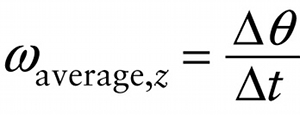Average angular velocity (8-1)
Question 1 of 3
Question
Duration of the time inteval
{"title":"Average angular velocity of a rotating object over a time interval (can be + or −)","description":"Incorrect","type":"incorrect","color":"#99CCFF","code":"[{\"shape\":\"poly\",\"coords\":\"82,133\"},{\"shape\":\"rect\",\"coords\":\"5,39,44,74\"}]"} {"title":"Angular displacement of the object during the time interval (can be + or −)","description":"Wrong","type":"incorrect","color":"#ffcc00","code":"[{\"shape\":\"rect\",\"coords\":\"118,11,119,13\"},{\"shape\":\"rect\",\"coords\":\"267,11,298,45\"}]"} {"title":"Duration of the time interval","description":"Correct!","type":"correct","color":"#333300","code":"[{\"shape\":\"rect\",\"coords\":\"264,72,289,105\"}]"}Review
Here ω is the Greek letter omega, and the z in the subscript tells us that the blade is rotating around an axis that we call the z axis (Figure 8-3). For any rotating rigid object, the value of ωaverage, z is the same for all pieces of the object. The average angular velocity can be positive or negative, depending on the direction in which the object rotates. A common choice is to take counterclockwise rotation to be positive and clockwise rotation to be negative, but the choice is up to you.

